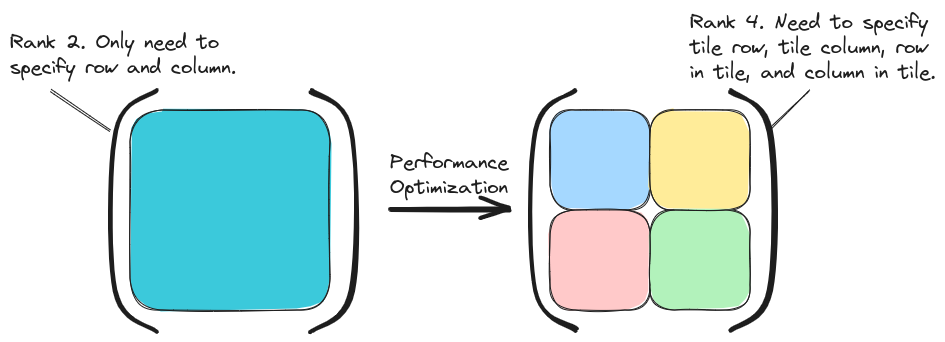Logical Versus Physical: Understanding the Tensor Layout
Most tensor libraries conceptually support what we call physical and logical layouts; however, they often do not distinguish among them. The point of this page is to introduce the logical vs. physical concept, provide some examples, and explain why the explicit distinction is important.
Motivation
Ideally, users of a tensor library should only have to specify the properties of the tensor as they relate to the problem being modeled. Roughly speaking, this amounts to the literal values of the tensor, the symmetry of the tensor, and the sparsity of the tensor. The literal implementation may need additional structure, for example tiling and distribution. This additional structure effectively changes the properties of the tensor (vide infra), and moreover this additional structure may only appear on certain hardware.
In an effort to distinguish the problem-specific structure from the implementation-/hardware-specific structure we term the former the “logical” structure and the latter the “physical” structure. Generally speaking, the physical structure will describe how the tensor is actually structured, whereas the logical structure describes how the user thinks the tensor is structured.
Examples

Fig. 1 Illustration of how tiling a tensor effectively changes its rank.
The motivation for introducing the logical vs. physical distinction is tiling of a tensor. Fig. 1 illustrates this process for a matrix. The left side of Fig. 1 shows the logical view of the matrix. This is how the end-user thinks of the tensor, i.e., it’s some number of rows by some number of columns. When the user interacts with this tensor they expect to give two indices, one for the row and one for the column. All interactions of the end-user with the tensor should behave like the tensor is a matrix.
The right side of Fig. 1 shows how TensorWrapper “physically” lays out a tiled matrix, namely a matrix of matrices. Row and column offsets in the outer matrix are used to select a tile. Row and column offsets in a tile are used to select an element. In turn, when interacting with the physical tensor a user needs to provide four indices. Clearly the logical and physical views are not compatible without knowing the mapping.
Summary
Ideally users will interact with tensors in a manner dictated by the problem being modeled. This “logical” interaction will ideally be performance portable.
Ideally, TensorWrapper will automatically map the logical view to a “physical” performant representation.
Generally speaking, the physical representation will not be the same as the logical representation.
In practice, TensorWrapper is unlikely to automate the logical to physical mapping anytime soon so users will likely need to consider both the logical and physical representations.
By distinguishing between logical and physical views and writing TensorWrapper infrastructure in terms of the physical views we can move towards ideality by having the logical views dispatch to the physical views.